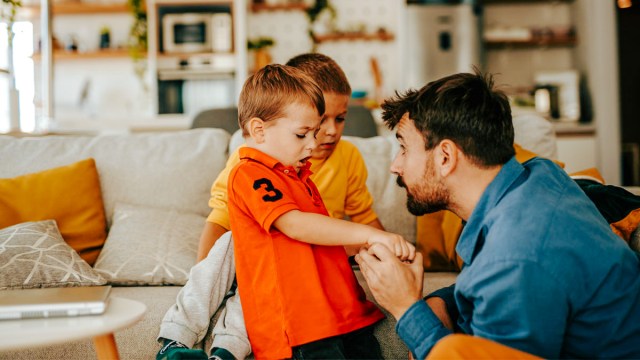It’s so startling when our little kids lays a big smack on us (or anyone, for that matter), but it’s also super common. Nope, you’re not failing as a parent, and you likely don’t have a problem child, either. What you’ve got is a toddler or preschool kiddo learning to deal with big emotions that swing wildly in different directions throughout the day. TBH, it’s almost like having a moody teenager in the house, but one who’s a lot smaller, a lot handsier, and needs more help in practically every department. So how do we deal with toddler hitting?
Mandy Grass, a behavior analyst and parent coach, explains in a recent TikTok that when dealing with big feelings, clear and calm phrases like “We don’t hit” or “You can be mad, but you do not hit mommy” are a good start, but there’s something parents often forget. She lays it out in her video:
We can tell our littles what not to do until we’re blue in the face, but it doesn’t help them understand how they should act—and that’s the missing link.
We need to tell kids what they CAN do.
We very naturally jump to point out the things kids shouldn’t do. But, as Grass explains, flipping our responses when they’re having an outburst of emotions might be more effective. “Sometimes, we’re so caught up in responding to behavior… but we are not teaching. That emotion still exists, that anger still exists, that anger is valid, so tell them what to do,” says Grass.
For Grass, a key element of knowing what to do when your kid hits you is offering a replacement behavior: clenching their fists, stomping their feet, yelling into a pillow, or taking space in the quiet corner. “Start focusing on and modeling that; inundate them with those options. It’s not a magic wand, but if implemented consistently for a couple of days or a week, it can make a difference,” she says.
Related: How 3 “Yes” Statements Can Defuse an Angry Kid
We also need to SHOW them what that looks like.
If you want another trick to add to your parenting arsenal, Grass suggests showing your kids how they can touch by not just saying “We use gentle touch” but demonstrating what it looks like. For example, “You can touch mommy’s hand like this, or you can put your hands in quiet hands [with fingers laced] and take some space.” It’s so important not just to say “You use gentle hands” but to show what gentle touch looks like. “Focus on what to do, and model, model, model,” she stresses.
No one wants their tot to lash out or get physical, but they’re all on the same learning curve. It’s our job as parents to teach them to deal with anger safely. Like any new skill, it takes time and practice, but it’s one that they’ll use throughout their lives, and that’s a big win for everyone.











